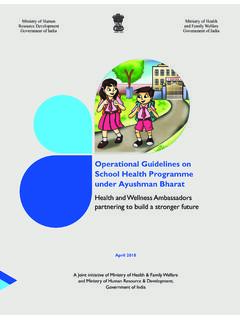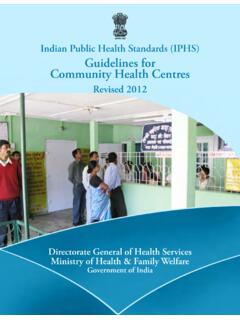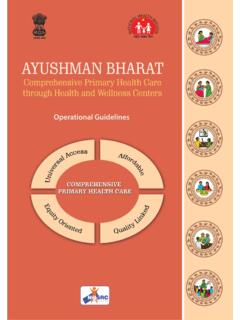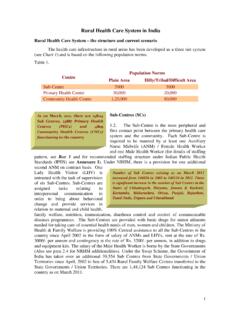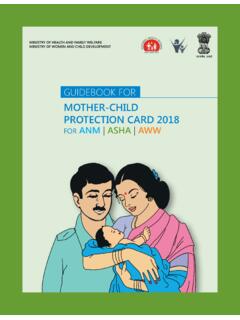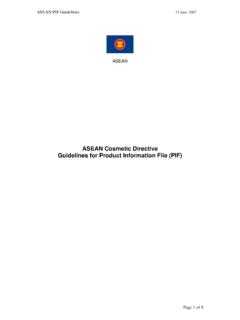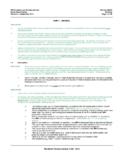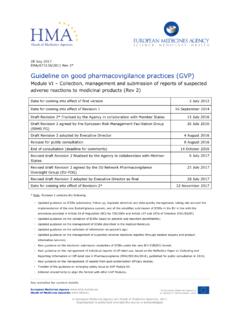Transcription of Guidelines on ASHA - NHM
1 Guidelines ON. ACCREDITED SOCIAL HEALTH ACTIVITISTS (ASHA). 1. BACKGROUND. The Government of India has decided to launch a National Rural Health Mission (NRHM) to address the health needs of rural population, especially the vulnerable sections of society. The Sub-centre is the most peripheral level of contact with the community under the public health infrastructure. This caters to a population norm of 5000, but is effectively serving much larger population at the Sub-centre level, especially in EAG States. With only about 50% MPW (M). being available in these States, the ANM is heavily overworked, which impacts outreach services in rural areas. Currently Anganwadi Workers (AWWs) under the Integrated Child Development Scheme (ICDS) are engaged in organizing supplementary nutrition programmes and other supportive activities. The very nature of her job responsibilities (with emphasis on supplementary feeding and pre school education) does not allow her to take up the responsibility of a change agent on health in a village.
2 Thus a new band of community based functionaries, named as Accredited Social Health Activist (ASHA) is proposed to fill this void. ASHA will be the first port of call for any health related demands of deprived sections of the population, especially women and children, who find it difficult to access health services. In following paragraphs, the role, responsibilities, profile, selection procedure, training modality and compensation package for ASHA has been explained. It has been envisaged that states will have flexibility to adapt these Guidelines keeping their local situations in view. 2. ROLES & RESPONSIBILITIES. ASHA will be a health activist in the community who will create awareness on health and its social determinants and mobilize the community towards local health planning and increased utilization and accountability of the existing health services. She would be a promoter of good health practices.
3 She will also provide a minimum package of curative care as appropriate and feasible for that level and make timely referrals. Her roles and responsibilities would be as follows: ASHA will take steps to create awareness and provide information to the community on determinants of health such as nutrition, basic sanitation & hygienic practices, healthy living and working conditions, information on existing health services and the need for timely utilization of health & family welfare services. She will counsel women on birth preparedness, importance of safe delivery, breast- feeding and complementary feeding, immunization, contraception and prevention of common infections including Reproductive Tract Infection/Sexually Transmitted Infection (RTIs/STIs) and care of the young child. 1. ASHA will mobilize the community and facilitate them in accessing health and health related services available at the village/sub-center/primary health centers, such as Immunization, Ante Natal Check-up (ANC), Post Natal Check-up (PNC), ICDS, sanitation and other services being provided by the government.
4 She will work with the Village Health & Sanitation Committee of the Gram Panchayat to develop a comprehensive village health plan. She will arrange escort/accompany pregnant women & children requiring treatment/. admission to the nearest pre-identified health facility Primary Health Centre/. Community Health Centre/ First Referral Unit (PHC/CHC /FRU). ASHA will provide primary medical care for minor ailments such as diarrhoea, fevers, and first aid for minor injuries. She will be a provider of Directly Observed Treatment Short-course (DOTS) under Revised National Tuberculosis Control Programme. She will also act as a depot holder for essential provisions being made available to every habitation like Oral Rehydration Therapy (ORS), Iron Folic Acid Tablet (IFA), chloroquine, Disposable Delivery Kits (DDK), Oral Pills & Condoms, etc. A Drug Kit will be provided to each ASHA. Contents of the kit will be based on the recommendations of the expert/technical advisory group set up by the Government of India.
5 Her role as a provider can be enhanced subsequently. States can explore the possibility of graded training to her for providing newborn care and management of a range of common ailments particularly childhood illnesses. She will inform about the births and deaths in her village and any unusual health problems/disease outbreaks in the community to the Sub-Centres/Primary Health Centre. She will promote construction of household toilets under Total Sanitation Campaign. Fulfillment of all these roles by ASHA is envisaged through continuous training and up- gradation of her skills, spread over two years or more. 3. SELECTION OF ASHA. The general norm will be One ASHA per 1000 population'. In tribal, hilly, desert areas the norm could be relaxed to one ASHA per habitation, dependant on workload etc. The States will also need to work out the district and block-wise coverage/phasing for selection of ASHAs.
6 It is envisaged that the selection and training process of ASHA will be given due attention by the concerned State to ensure that at least 40 percent of the envisaged 2. ASHAs in the State are selected and given induction training in the first year as per the norms given in the Guidelines . Rest of the ASHAs can subsequently be selected and trained during second and third year. Criteria for Selection ASHA must be primarily a woman resident of the village - Married/Widow/Divorced' and preferably in the age group of 25 to 45 yrs. ASHA should have effective communication skills, leadership qualities and be able to reach out to the community. She should be a literate woman with formal education up to Eighth Class. This may be relaxed only if no suitable person with this qualification is available. Adequate representation from disadvantaged population groups should be ensured to serve such groups better.
7 Selection Process The selection of ASHAs would have to be done carefully. The District Health Society envisaged under NRHM would oversee the process. The Society would designate a District Nodal Officer, preferably a senior health person, who is able to ensure that the Health Department is fully involved. S/he would also act as a link with the NGOs and with other departments. The Society would designate Block Nodal Officers, preferably Block Medical Officers, to facilitate the selection process, organizing training for Trainers and ASHA as per the Guidelines of the scheme. 1. The Block Nodal Officer would identify 10 or more Facilitators in each Block so that one facilitator covers about 10 villages. The facilitators should preferably be women from local NGOs;. Community based groups, Mahila Samakhyas, Anganwadis or Civil Society Institutions. In case none of these is available in the area, the officers of other Departments at the block or village level/local school teachers may be taken as facilitators.
8 2. These facilitators should be oriented about the scheme in a 2-day workshop which should be held at the district level under supervision of the District Nodal Officer. During this meeting, the Block Nodal Officers should also be present. The District Nodal Officer will brief the facilitators and Block Nodal Officers on the selection criteria and importance of proper selection in effective achievement of the objectives of the same and also the role of facilitators and Block Nodal Officers are required to play in ensuring the quality of the selection process. 3. The facilitators would be required to interact with community by conducting Focused Group Discussions (FGDs) / workshops of the local self help groups etc. This should lead to awareness of roles and responsibilities of ASHA and acceptance of ASHA as a concept in the community. This interaction should result in short listing of at least three names from each village.
9 4. Subsequently a meeting of the Gram Sabha would be convened to select one out of the three shortlisted names. The minutes of the approval process in Gram Sabha shall be recorded. The Village Health Committee would enter into an agreement with the ASHA as in the case of the Village Education Committee and Sahayogini in Sarva Shiksha Abhiyan. The name will be forwarded by the Gram Panchayat to the District Nodal Officer for record. State Governments may modify these Guidelines except that no change may be done in the basic criteria of ASHA being a woman volunteer with minimum education up to VIII class and that she 3. would be a resident of the village. In case any of the selection criteria or Guidelines is modified, these should be widely disseminated in local languages. 4. INSTITUTIONAL ARRANGEMENTS. The success of ASHA scheme will depend on how well the scheme is implemented and monitored. It will also depend crucially on the motivational level of various functionaries and the quality of all the processes involved in implementing the scheme.
10 It is therefore necessary that well defined and yet flexible and participatory institutional structures are put into place at all levels from state level to village level. ASHA will be a central component of the National Rural Health Mission (NRHM) and its institutional structure would reflect this. (a) The District Health Society under the chairmanship of the District Magistrate/President Zila Parishad will oversee the selection process. Society will have representation from all related departments and civil society and the Panchayti Raj Institutions (PRIs). The Society will designate a District Nodal Officer and a Block Nodal Officer preferably a senior health person. The job of the Nodal Officers at the District and Block will be to facilitate the selection process by involving the Gram Sabha and Gram Panchayat, holding of training for ASHA and for trainers as per the Guidelines of the scheme.
